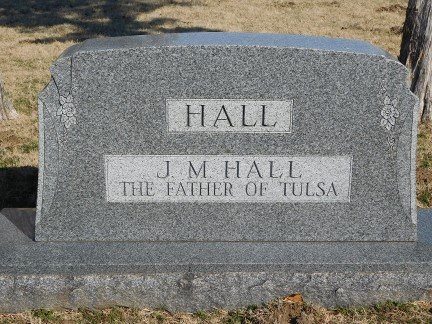


 |
 |  |
James Monroe "JM" Hall

|
Information furnished by Jo Aguirre
Dec 4, 1851 - May 26, 1935
J. M. replaced the tent with a permanent structure at what would be named First Street and Main Street, just south of the railroad tracks. According to his obituary in the Tulsa World, the one-story building was 25 feet by 50 feet, with a 16-foot lean-to on the north side and a 12-foot lean-to on the south side. He later added a second story and enclosed the property with a fence. Still later, he replaced the original building with a two-story brick building that was known for many years after as the Hall Building. J. M. and Harry operated the store until Harry died in March, 1906. J. M. continued to operate the store until 1908, when he sold out to pursue banking and other interests.
Robert McGill Loughridge, preached the first sermon on the porch of the Hall store in 1883 J.M was a devout Presbyterian, and has been credited with organizing First Presbyterian Church of Tulsa. It was the first permanent Protestant church in Tulsa and they began meeting at the store in 1885. The first ministers at this church were Presbyterian missionaries, whose salaries were paid by their denomination, the Presbyterian Church of the United States of America (PCUSA). J.M. organized a Sunday School, spending the next forty years as its superintendent. He organized a group of citizens to erect a structure that would serve as both a school and a church. The Presbyterian Church sent two missionary teachers and a minister, Rev. William Haworth, to staff the school. Haworth would serve until 1900 as the first permanent Presbyterian minister in Tulsa when Charles William Kerr arrived.
In 1889, J. M. Hall, Jay Forsythe, R. M. Bynum and Joe Price bought the site occupied by the Presbyterian Mission Day School from the Presbyterian Board for $1,050. They held the title until Tulsa was incorporated, then deeded the property to Tulsa for use as a school. In 1906, the mission building was razed and the property became the site of Tulsa High School.
J.M. was one of the organizers of the Commercial Club in 1902, a forerunner of the Tulsa Chamber of Commerce. He served as president of the club in 1904. He was also one of the club members who put together a successful bid in 1907 to move Henry Kendall College from Muskogee to Tulsa. He remained an active member of the club until 1932, when he was gr anted an honorary life membership Hall also served on the Board of Trustees for 25 years, even after Kendall College became the University of Tulsa in 1920.
James M. Hall died May 26, 1935 at his home, 1801 Admiral Boulevard in Tulsa.
Funeral services were held at the First Presbyterian Church and conducted by Charles William Kerr, the first permanent minister of that church.
Hall is survived by his widow, three daughters and a son. He is buried in Rose Hill Cemetery and his tombstone bears the inscription "Father of Tulsa."
This site may be freely linked, but not duplicated in any way without consent.
All rights reserved! Commercial use of material within this site is prohibited!
© 2000-2025 Oklahoma CemeteriesThe information on this site is provided free for the purpose of researching your genealogy. This material may be freely used by non-commercial entities, for your own research, as long as this message remains on all copied material. The information contained in this site may not be copied to any other site without written "snail-mail" permission. If you wish to have a copy of a donor's material, you must have their permission. All information found on these pages is under copyright of Oklahoma Cemeteries. This is to protect any and all information donated. The original submitter or source of the information will retain their copyright. Unless otherwise stated, any donated material is given to Oklahoma Cemeteries to make it available online. This material will always be available at no cost, it will always remain free to the researcher.